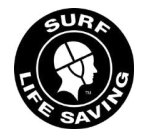(a) Each team shall comprise one driver, one crewperson and one patient.
(b) The patient is positioned as described in Procedure Rule 3.3.3.1.
(c) For this event only, the rescue tube (excluding harness/lanyard and rope) is to be stowed securely under the spray dodger at the start of the event.
(d) The start shall be as described in Procedure Rules 3.3.3.2 and 3.3.3.3.
(e) Following the start and while maintaining a secure position, the crewperson shall don the rescue tube harness in a safe manner prior to rounding the turning buoy.
(f) The IRB shall round the turning buoy anti-clockwise and then must remain wholly, i.e. all parts of the IRB, on the beach side of the turning buoy until the patient pick-up has commenced (see Rule 3.3.4.1 (k)).
(g) After the IRB has rounded the turning buoy, the crewperson shall leave the IRB from the shoreward side of the buoy. The rescue tube shall be unclipped and held by the crewperson as they exit the IRB.
(h) The crewperson shall then swim to their patient at their respective rescue tube patient buoy by the most direct route and then round the buoy in an anti-clockwise manner to collect their patient.
Note: The crewperson may pass by either side of the patient pick up buoy (used for events other than the IRB Rescue Tube Race) to reach their patient.
(i) The rescue tube must then be fastened around the patient and under both arms by the crewperson and/or patient. The patient may clip themselves into the tube unaided. The crewperson does not have to break stroke during this process as long as the clip on the rescue tube is secured to an O-ring prior to the patient pick up commencing.
(j) The crewperson completes their 180 degrees anti-clockwise turn around the buoy and tows the patient to the IRB maintaining the patient pick-up buoy and turning buoy on their left hand side. The patient is permitted to assist by kicking, and sculling with arms under the surface, but must not swim with an out-of-water arm recovery. The patient must not be towed on their stomach. The use of swim fins, hand fins or other non-approved aids is not permitted.
(k) Once the driver makes visible physical contact with the patient (not the rescue tube harness) the patient pickup is deemed to have commenced and the IRB may cross to the seaward side of the turning buoy.
(l) The crewperson and patient shall board the IRB on the port side, with or without assistance from the driver. The driver may release the motor throttle grip and stand to assist the pick-up providing the motor is in neutral.
(m) The IRB shall continue anti-clockwise around the turning buoy. The patient and crewperson must be completely out of the water prior to the IRB proceeding back to the beach side of the turning buoy.
(n) The rescue tube shall remain around the patient and the crewperson shall remove the harness and pass it to the patient. The patient must then keep a secure grip on the lanyard/harness and rope/line until the driver exits the IRB to ensure that it does not snag anything within the IRB or extend past the transom or pass through either of the self-bailers.
Note: There is no requirement for the patient to hold their hand up with the lanyard/harness and rope/line at the completion of the race for judge notation purposes.
(o) The crew shall return to shore, as described in Procedure Rule 3.3.3.4.
(p) The finish shall be as described in Procedure Rule 3.3.3.6.

